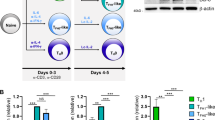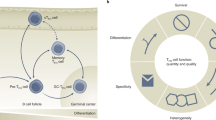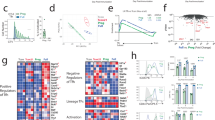Abstract
Follicular regulatory T cells (TFR cells) inhibit follicular helper T cell (TFH cell)–mediated antibody production. The mechanisms by which TFR cells exert their key immunoregulatory functions are largely unknown. Here we found that TFR cells induced a distinct suppressive state in TFH cells and B cells, in which effector transcriptional signatures were maintained but key effector molecules and metabolic pathways were suppressed. The suppression of B cell antibody production and metabolism by TFR cells was durable and persisted even in the absence of TFR cells. This durable suppression was due in part to epigenetic changes. The cytokine IL-21 was able to overcome TFR cell–mediated suppression and inhibited TFR cells and stimulated B cells. By determining mechanisms of TFR cell-mediated suppression, we have identified methods for modulating the function of TFR cells and antibody production.
This is a preview of subscription content, access via your institution
Access options
Subscribe to this journal
Receive 12 print issues and online access
$209.00 per year
only $17.42 per issue
Buy this article
- Purchase on Springer Link
- Instant access to full article PDF
Prices may be subject to local taxes which are calculated during checkout







Similar content being viewed by others
References
Linterman, M.A. et al. Foxp3+ follicular regulatory T cells control the germinal center response. Nat. Med. 17, 975–982 (2011).
Sage, P.T. & Sharpe, A.H. T follicular regulatory cells in the regulation of B cell responses. Trends Immunol. 36, 410–418 (2015).
Chung, Y. et al. Follicular regulatory T cells expressing Foxp3 and Bcl-6 suppress germinal center reactions. Nat. Med. 17, 983–988 (2011).
Wollenberg, I. et al. Regulation of the germinal center reaction by Foxp3+ follicular regulatory T cells. J. Immunol. 187, 4553–4560 (2011).
Crotty, S. T follicular helper cell differentiation, function, and roles in disease. Immunity 41, 529–542 (2014).
De Silva, N.S. & Klein, U. Dynamics of B cells in germinal centres. Nat. Rev. Immunol. 15, 137–148 (2015).
McHeyzer-Williams, M., Okitsu, S., Wang, N. & McHeyzer-Williams, L. Molecular programming of B cell memory. Nat. Rev. Immunol. 12, 24–34 (2011).
Crotty, S. A brief history of T cell help to B cells. Nat. Rev. Immunol. 15, 185–189 (2015).
Crotty, S. Follicular helper CD4 T cells (TFH). Annu. Rev. Immunol. 29, 621–663 (2011).
Stone, E.L. et al. ICOS coreceptor signaling inactivates the transcription factor FOXO1 to promote Tfh cell differentiation. Immunity 42, 239–251 (2015).
Choi, Y.S. et al. ICOS receptor instructs T follicular helper cell versus effector cell differentiation via induction of the transcriptional repressor Bcl6. Immunity 34, 932–946 (2011).
Sage, P.T., Alvarez, D., Godec, J., von Andrian, U.H. & Sharpe, A.H. Circulating T follicular regulatory and helper cells have memory-like properties. J. Clin. Invest. 124, 5191–5204 (2014).
Sage, P.T., Francisco, L.M., Carman, C.V. & Sharpe, A.H. The receptor PD-1 controls follicular regulatory T cells in the lymph nodes and blood. Nat. Immunol. 14, 152–161 (2013).
Sage, P.T., Paterson, A.M., Lovitch, S.B. & Sharpe, A.H. The coinhibitory receptor CTLA-4 controls B cell responses by modulating T follicular helper, T follicular regulatory, and T regulatory cells. Immunity 41, 1026–1039 (2014).
Wing, J.B., Ise, W., Kurosaki, T. & Sakaguchi, S. Regulatory T cells control antigen-specific expansion of Tfh cell number and humoral immune responses via the coreceptor CTLA-4. Immunity 41, 1013–1025 (2014).
Sage, P.T. & Sharpe, A.H. In vitro assay to sensitively measure T(FR) suppressive capacity and T(FH) stimulation of B cell responses. Methods Mol. Biol. 1291, 151–160 (2015).
Sage, P.T. & Sharpe, A.H. T follicular regulatory cells. Immunol. Rev. 271, 246–259 (2016).
Godec, J. et al. Compendium of immune signatures identifies conserved and species-specific biology in response to inflammation. Immunity 44, 194–206 (2016).
Schubart, D.B., Rolink, A., Kosco-Vilbois, M.H., Botteri, F. & Matthias, P. B-cell-specific coactivator OBF-1/OCA-B/Bob1 required for immune response and germinal centre formation. Nature 383, 538–542 (1996).
Shaffer, A.L. et al. XBP1, downstream of Blimp-1, expands the secretory apparatus and other organelles, and increases protein synthesis in plasma cell differentiation. Immunity 21, 81–93 (2004).
Muramatsu, M. et al. Class switch recombination and hypermutation require activation-induced cytidine deaminase (AID), a potential RNA editing enzyme. Cell 102, 553–563 (2000).
Revy, P. et al. Activation-induced cytidine deaminase (AID) deficiency causes the autosomal recessive form of the Hyper-IgM syndrome (HIGM2). Cell 102, 565–575 (2000).
Shi, W. et al. Transcriptional profiling of mouse B cell terminal differentiation defines a signature for antibody-secreting plasma cells. Nat. Immunol. 16, 663–673 (2015).
Qian, J. et al. B cell super-enhancers and regulatory clusters recruit AID tumorigenic activity. Cell 159, 1524–1537 (2014).
Stine, Z.E., Walton, Z.E., Altman, B.J., Hsieh, A.L. & Dang, C.V. MYC, Metabolism, and cancer. Cancer Discov. 5, 1024–1039 (2015).
Dominguez-Sola, D. et al. The proto-oncogene MYC is required for selection in the germinal center and cyclic reentry. Nat. Immunol. 13, 1083–1091 (2012).
Calado, D.P. et al. The cell-cycle regulator c-Myc is essential for the formation and maintenance of germinal centers. Nat. Immunol. 13, 1092–1100 (2012).
Wang, J. et al. Evaluation of the antitumor effects of c-Myc-Max heterodimerization inhibitor 100258-F4 in ovarian cancer cells. J. Transl. Med. 12, 226 (2014).
Adams, J.M. et al. The c-myc oncogene driven by immunoglobulin enhancers induces lymphoid malignancy in transgenic mice. Nature 318, 533–538 (1985).
Powell, J.D., Pollizzi, K.N., Heikamp, E.B. & Horton, M.R. Regulation of immune responses by mTOR. Annu. Rev. Immunol. 30, 39–68 (2012).
Caro-Maldonado, A. et al. Metabolic reprogramming is required for antibody production that is suppressed in anergic but exaggerated in chronically BAFF-exposed B cells. J. Immunol. 192, 3626–3636 (2014).
Ron-Harel, N. et al. Mitochondrial biogenesis and proteome remodeling promote one-carbon metabolism for T cell activation. Cell Metab. 24, 104–117 (2016).
Kieffer-Kwon, K.R. et al. Interactome maps of mouse gene regulatory domains reveal basic principles of transcriptional regulation. Cell 155, 1507–1520 (2013).
Huong, T. et al. In vivo analysis of Aicda gene regulation: a critical balance between upstream enhancers and intronic silencers governs appropriate expression. PLoS One 8, e61433 (2013).
Fabrizi, M. et al. IL-21 is a major negative regulator of IRF4-dependent lipolysis affecting Tregs in adipose tissue and systemic insulin sensitivity. Diabetes 63, 2086–2096 (2014).
Peluso, I. et al. IL-21 counteracts the regulatory T cell-mediated suppression of human CD4+ T lymphocytes. J. Immunol. 178, 732–739 (2007).
Johnston, R.J. et al. Bcl6 and Blimp-1 are reciprocal and antagonistic regulators of T follicular helper cell differentiation. Science 325, 1006–1010 (2009).
Choi, Y.S. et al. LEF-1 and TCF-1 orchestrate TFH differentiation by regulating differentiation circuits upstream of the transcriptional repressor Bcl6. Nat. Immunol. 16, 980–990 (2015).
Liu, X. et al. Transcription factor achaete-scute homologue 2 initiates follicular T-helper-cell development. Nature 507, 513–518 (2014).
Oestreich, K.J., Mohn, S.E. & Weinmann, A.S. Molecular mechanisms that control the expression and activity of Bcl-6 in TH1 cells to regulate flexibility with a TFH-like gene profile. Nat. Immunol. 13, 405–411 (2012).
Kunisawa, J. et al. Mode of bioenergetic metabolism during B cell differentiation in the intestine determines the distinct requirement for vitamin B1. Cell Rep. 13, 122–131 (2015).
Ray, J.P. et al. The interleukin-2-mTORc1 kinase axis defines the signaling, differentiation, and metabolism of T felper 1 and follicular B helper T cells. Immunity 43, 690–702 (2015).
Shrestha, S. et al. Treg cells require the phosphatase PTEN to restrain TH1 and TFH cell responses. Nat. Immunol. 16, 178–187 (2015).
Huynh, A. et al. Control of PI(3) kinase in Treg cells maintains homeostasis and lineage stability. Nat. Immunol. 16, 188–196 (2015).
Fridman, A.L. & Tainsky, M.A. Critical pathways in cellular senescence and immortalization revealed by gene expression profiling. Oncogene 27, 5975–5987 (2008).
McKinney, E.F., Lee, J.C., Jayne, D.R., Lyons, P.A. & Smith, K.G. T-cell exhaustion, co-stimulation and clinical outcome in autoimmunity and infection. Nature 523, 612–616 (2015).
Wherry, E.J. et al. Molecular signature of CD8+ T cell exhaustion during chronic viral infection. Immunity 27, 670–684 (2007).
Bettelli, E. et al. Reciprocal developmental pathways for the generation of pathogenic effector TH17 and regulatory T cells. Nature 441, 235–238 (2006).
Buenrostro, J.D., Giresi, P.G., Zaba, L.C., Chang, H.Y. & Greenleaf, W.J. Transposition of native chromatin for fast and sensitive epigenomic profiling of open chromatin, DNA-binding proteins and nucleosome position. Nat. Methods 10, 1213–1218 (2013).
McLean, C.Y. et al. GREAT improves functional interpretation of cis-regulatory regions. Nat. Biotechnol. 28, 495–501 (2010).
Acknowledgements
We thank the Nikon Imaging Center at Harvard Medical School for help with light microscopy and the MBIB flow cytometry core for help with flow cytometry. Supported by the US National Institute of Health (T32HL007627 to P.T.S.; and R37AI38310, P01AI56299 and P01AI065687 to A.H.S.) and the Evergrande Center for Immunologic Diseases.
Author information
Authors and Affiliations
Contributions
P.T.S. performed all experiments and analyzed data; N.R.-H. performed metabolic-flux analysis; N.R.-H. and M.H. provided technical help on metabolic pathways; V.R.J. provided technical help on RNA-seq experiments; D.R.S. and W.N.H. prepared ATAC-seq samples and provided technical assistance on ATAC-seq analysis; S.M. provided technical help; W.S. and V.K.K. provided Il21r−/− mice and technical help; N.C. provided the RNA-seq library-preparation protocol and provided technical help; and P.T.S. and A.H.S. conceived of the project and wrote the manuscript.
Corresponding author
Ethics declarations
Competing interests
The authors declare no competing financial interests.
Integrated supplementary information
Supplementary Figure 1 Sorting gates for TFH cells, TFR cells and B cells.
(a) Schematic of Suppression assay. FoxP3-GFP reporter mice were immunized with NP-OVA and 7 days later dLN were harvested and CD19+ B cells and CD4+CXCR5+ICOS+FoxP3-CD19- TFH cells were cultured with or without CD4+CXCR5+ICOS+FoxP3+CD19- TFR cells in the presence of anti-CD3/IgM. (b) Sort strategy for sorting TFH and TFR cells. (c) Class switch to IgG1 in suppression assays in which B and TFH cells were cultured with or without TFR cells along with NP-OVA.
Supplementary Figure 2 Additional characterization of activated and suppressed B cells based on RNA-seq analysis.
(a) Schematic of experiment. B and TFH cells, sorted from NP-OVA immunized FoxP3GFP mice, were cultured alone (“Activated”) or with TFR cells (“Suppressed”) sorted from FoxP3GFP ActinCFP mice, in the presence of NP-OVA. After 4 days CD19+IA+CD4-CFP- B and CD4+CD19-IA-CFP- TFH cells were sorted and processed for RNA-seq analysis. (b) Sorting gates for B cells. (c) Volcano plots showing genes in B and TFH cells in the context of activated or suppressed cultures. (d) Heat map of genes differentially expressed (FDR corrected p<0.05) in B and TFH cells from activated versus suppressed cultures. (e) Genes differentially expressed in both TFH and B cells in activated versus suppressed cultures.
Supplementary Figure 3 Metabolic pathway analysis of activated B cells versus suppressed B cells.
Metabolic map of essential enzymes in glycolysis, 1-carbon metabolism and serine biosynthesis. Blue indicates transcripts that are statistically lower in suppressed versus activated B cells. Gray indicates no significant change. Red indicates transcripts that are more abundant in suppressed versus activated B cells (none were found).
Supplementary Figure 4 Expanded analysis of metabolic pathways.
(a) Heat maps of individual genes in metabolic pathways (shown in Fig. 4a ) from suppression assays in which B and TFH (Act B) or B, TFH and TFR (Supp B) were cultured.
Supplementary Figure 5 Additional analysis of altered metabolic pathways in TFR cell–suppressed B cells.
(a) Glut1 staining in B cells for experiments shown in Fig. 4b. (b) (left) Gating of division number for experiments shown in Fig. 4c. (right) IgG1+ staining in B cells gated by division number. (c) IgG1+ staining in B cells that were added to 3 day cultures and harvested 20 hours later as in Fig. 4d. (d) Glutamine uptake measured from culture supernatants from cultures as in Fig 4b. CD4+ICOS–CXCR5–FoxP3+ Treg cells were added in some conditions. (e) IgG1+ B cells in culture supernatants from cultures as in (a) with the addition of glutaminolysis inhibitor BPTES.
Supplementary Figure 6 Antibody measurements in reactivation of suppressed B cells.
(a) Schematic of restimulation of suppressed B cells. (b) Antibody measurements from restimulation of suppressed B cells. B cells were sorted from suppressed cultures and cultured with new TFH cells in the presence of anti-CD3/IgM for 6 days. IgG from culture supernatants were measured by ELISA.
Supplementary Figure 7 Expanded analysis of ‘IL-21 rescue’ experiments.
(a) Cell count (left), IgG1+ staining (middle) and Glut1 expression (right) on B cells from suppression assays in which IL21, IL6 or IL4 were added. (b) Cell count (left), IgG1+ staining (middle) and Glut1 expression (right) on B cells from suppression assays in which WT or Il21r-/- B cells were cultured as well as IL-21. (c) Heat map of genes downregulated in activated versus suppressed B cells, but not rescued with the addition of IL-21.
Supplementary information
Supplementary Text and Figures
Supplementary Figures 1–7 and Supplementary Table 1 (PDF 1874 kb)
Supplementary Video 1
Time lapse movie showing TFR cell dynamics (MOV 850 kb)
Rights and permissions
About this article
Cite this article
Sage, P., Ron-Harel, N., Juneja, V. et al. Suppression by TFR cells leads to durable and selective inhibition of B cell effector function. Nat Immunol 17, 1436–1446 (2016). https://doi.org/10.1038/ni.3578
Received:
Accepted:
Published:
Issue Date:
DOI: https://doi.org/10.1038/ni.3578
This article is cited by
-
Triptolide regulates the balance of Tfr/Tfh in lupus mice
Advances in Rheumatology (2023)
-
Follicular Helper T Cells and Follicular Regulatory T Cells Involved in Immune Disorders of Idiopathic Membranous Nephropathy
Indian Journal of Pediatrics (2023)
-
The impact of HIV infection on the frequencies, function, spatial localization and heterogeneity of T follicular regulatory cells (TFRs) within human lymph nodes
BMC Immunology (2022)
-
Different antibody-associated autoimmune diseases have distinct patterns of T follicular cell dysregulation
Scientific Reports (2022)
-
The link between circulating follicular helper T cells and autoimmunity
Nature Reviews Immunology (2022)



